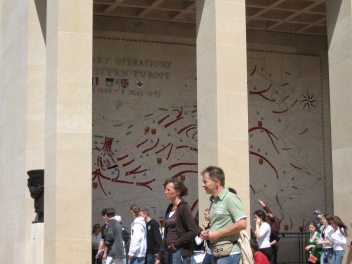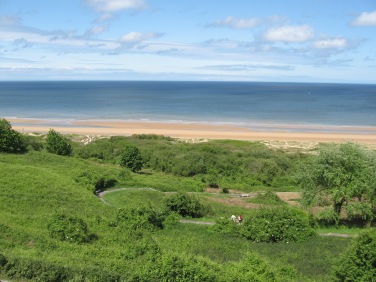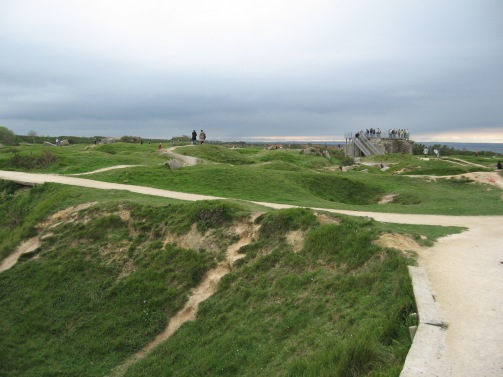Seventy years ago, on the 6th of June 1944, the Allied Invasion of Normandy began.
Of all the countries I’ve lived in, none matches France in terms of seeing/living history. History in France is part of your every day life, whether you realize it or not. Roman ruins and aqueducts border rivers; Romanesque, medieval, gothic churches and architecture is side by side with modern and contemporary structures. Buildings and streets have plaques explaining which historical figure lived there or which battle it commemorates. Bunkers and war shelters remain from world wars, as do pockmarked lands that never recovered from bombings. Studying the world wars in France meant seeing parts of history with our own eyes, not just learning about them in class and reading about them in our books.
In 10th grade we visited the fields of the Somme – where thousands of soldiers were killed in the bloody trench warfare of World War I. The fields where red poppies bloom every year, said to be colored by the blood of the fallen. There were no grandiose cemeteries or monuments here – simply fields of white stones set in the lush green grass and a few wildflowers. Unfortunately I have no photos of our visit to the Somme, but the image remains clear in my mind, as if I saw it yesterday. I recall the reconverted bomb shelters – now a museum with artifacts and documents, to give an idea of what it was like in those underground tunnels. But mostly I recall seeing those green fields with stark white crosses, under a blue sky with the sun passing behind the drifting, fluffy white clouds, as we drove by in our bus. I sometimes wonder why I remember it so clearly, but something about the natural beauty and simplicity of those fields touched me.
Later that same school year, while we were studying WWII, we spent a few days in Normandy. After that visit I returned twice more to Normandy and every time I was awed by the living history I could view with my own eyes. I remember that our first stop was Arromanches – the beach where the Allies built Mulberry harbor, the floating harbor used to land the troops and equipment in Normandy. There are still parts of the harbor standing today. Seventy years later, and we can see still parts floating a distance away from the beach. And to help you visualize it better, there is a museum near the beach that has a full replica model of the harbor… Although nothing beats seeing the actual remains. Yes, it is technically simply debris floating in the ocean, but imagine the circumstances in which it got there. Remember all the history and stories behind it. If you’re still not awed after that, I don’t know what to do with you.
While we were in Normandy, we also visited a small town called Saint-Mère-Eglise, where parachutists landed and many lost their lives. One parachutist got caught on a church steeple, stuck there until the Germans cut him down and took him prisoner. He later escaped and rejoined his regiment, but the town has kept a mannequin parachutist hanging off the steeple since. It is a tribute to the fallen and the town’s way of commemorating the event. A medieval church, with a WWII parachutist hanging on it – history clashes, mingles and reconstructs itself in France. It never ceases to amaze me.
I continued to be amazed and awestruck as we visited the wide, flat expanse of Omaha beach, imagining all those soldiers seeking cover where there is none. I was moved and overwhelmed by the sheer numbers of crosses and tombstones at the American cemetery. It is a beautiful and peaceful place, with pines lining a path overlooking the ocean and Omaha beach. There are walls of commemorations, maps showing the invasion and numbers of how many were lost. It is lush and green, with stark white stones, but there are no wildflowers here. It is a tidy, man-kept beauty, less wild and simple than the Somme. It is not more or less beautiful, simply different.
And finally we visited Pointe du Hoc. I think I was most touched and moved by this place during our Normandy visit. Pointe du Hoc is a cliff top, overlooking the ocean. There are no easy climbs or soft slopes to the top – just sheer edges and rugged cliffs. At the top of the cliffs there is barbed wire – a lot of barbed wire. The cliff top is riddled with craters created by shelling. Deep, large craters now covered in grass, but forever part of the landscape. There are bunkers and bomb shelters that you can enter, being careful about the barbed wire that is still present in many areas. The wind from the ocean blows hard and adds to the sad beauty of the landscape. It is a place I like best when there are few people and little man-made noise. There is something infinitely sad yet peaceful about that ravaged landscape, with the sound of the waves crashing against the cliffs below and the wind lifting my hair around my face. It is truly a place of living history, although so many died on both sides to protect it, capture it and liberate it.
There is obviously so much more to Normandy than the D-Day landings, but the occasion called for these particular memories. On this 70th anniversary of the Normandy landings I felt compelled to share some of my memories and experiences there. There is something so incredible about visiting historical places and touching a piece of history. My visit to Normandy was the first time I really understood that and it was a powerful lesson.
You know there is a saying
That sunshine follows rain,
And sure enough you’ll realize
That joy will follow pain.
Let courage be your password,
Make fortitude your guide;
And then instead of grousing,
Just remember those who died.
This is the final stanza of an anonymous poem that was found written on the wall of a solitary confinement cell at Dulag Luft, where most captured Allied airmen (in WWII) were sent for interrogation before being assigned to a permanent POW camp.

















